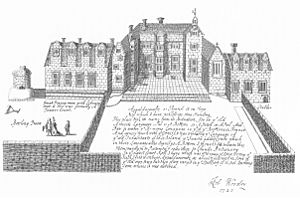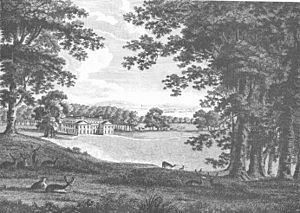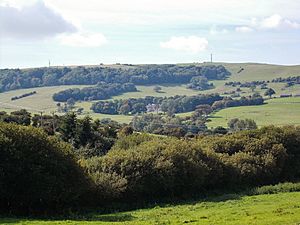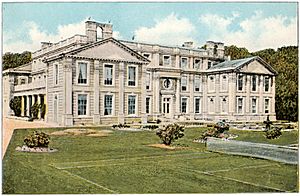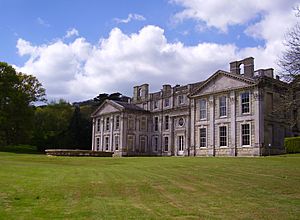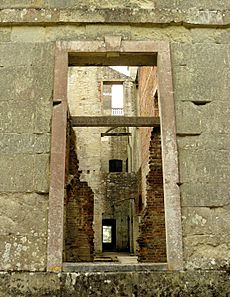Appuldurcombe House facts for kids
Quick facts for kids Appuldurcombe House |
|
|---|---|
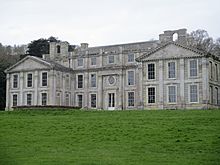 |
|
| General information | |
| Type | House |
| Architectural style | English Baroque |
| Location | Wroxall |
| Coordinates | 50°37′03″N 1°13′59″W / 50.617633°N 1.233124°W |
| Construction started | 1702 |
| Design and construction | |
| Architect | John James |
Appuldurcombe House is a large country house on the Isle of Wight, England. It was built in the 1700s by the Worsley family. Today, it is mostly a shell, but it's managed by English Heritage and is open for you to visit.
The house is near Wroxall. It used to have a huge estate around it, about 300 acres! You can still see parts of the old estate in the nearby farmland and village.
Contents
History of Appuldurcombe House
Appuldurcombe has a very long history. It started around 1100 as a priory, which is a type of religious house. Later, it became a convent, another kind of religious community.
In the Elizabethan times, it became a family home for the Leigh family. In 1690, the large Tudor mansion was given to Sir Robert Worsley. He decided it was time for a new, grander house. He wrote about the old house, saying he didn't leave "one stone standing" of it! He also explained that the name "Appuldurcombe" comes from old languages, meaning something like "a pool in a bottom" or "water in a valley."
Building the Baroque Mansion (1702)
The house you see today was started in 1702. The architect who designed it was John James. Sadly, Sir Robert Worsley passed away in 1747 before the house was fully finished. There's a monument to him on Stenbury Down, overlooking the house.
The house became even bigger in the 1770s. This was thanks to Sir Richard Worsley, who was Sir Robert's great-nephew. Sir Richard brought his new wife, Seymour Dorothy Fleming, to the newly extended mansion.
Around this time, in 1779, a famous landscape designer named Capability Brown was hired. He designed the beautiful gardens and parkland around the house. A fun, fake ruined castle called "Cooke’s Castle" was also built on a nearby hill. This was to make the view from the house even more interesting!
During Sir Richard's time, Appuldurcombe House was full of amazing art. It was also a place where many important people of the time were entertained.
Sir Richard and his wife separated, and their only child died when he was a baby. Sir Richard passed away in 1805. He had left the estate with a lot of money owed.
The house then went to his niece, Henrietta Anna Maria Charlotte. She married Charles Anderson-Pelham in 1806. He later became the first Earl of Yarborough. He loved sailing and founded the Royal Yacht Squadron at Cowes. He didn't make many changes to the house, using it as a handy spot for his sailing trips.
In 1855, the estate was sold. For a while, Appuldurcombe was run as a hotel, but it didn't do well. Then, it was rented out as a school for young gentlemen. From 1901 to 1907, about a hundred Benedictine monks lived there. They had come from France and later moved to Quarr Abbey on the Isle of Wight.
Damage During World War II
During both World Wars, soldiers stayed in the house. At the start of the Second World War, the military took it over. On February 7, 1943, a German plane dropped a mine very close to the house. The mine exploded, breaking windows and causing part of the roof to fall in.
The hole in the roof was never fixed. After the war, much of the rest of the roof and the inside parts of the house were taken away and sold. This is why the house is mostly a shell today.
Appuldurcombe House Today
Even though Appuldurcombe House is mostly a shell, the front part has a new roof and windows. A small part of the inside has been rebuilt to show how it might have looked.
The house is also known for being one of the most supposedly haunted places on the Isle of Wight! Many people tell stories and claim to have seen ghosts or other strange things there. During the summer holidays, you can even join weekly ghost walks at Appuldurcombe on Thursday evenings. It's a spooky and fun way to explore the history of the house!
Images for kids


